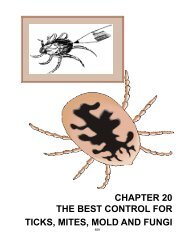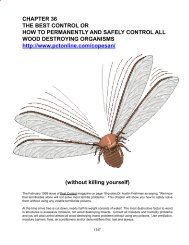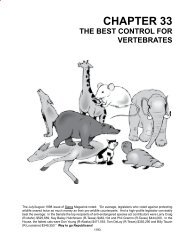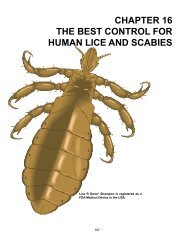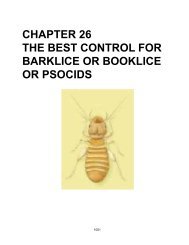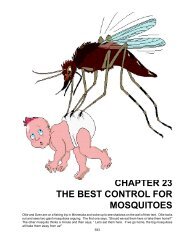CHAPTER 11 - The Best Control 2
CHAPTER 11 - The Best Control 2
CHAPTER 11 - The Best Control 2
- No tags were found...
Create successful ePaper yourself
Turn your PDF publications into a flip-book with our unique Google optimized e-Paper software.
this slow-acting poison which can take up to 10 days to kill them. Boric acid is very lethal to roaches; 20 ug(one ug = one million part of a gram) can kill a 50 mg German roach. Boric acid can stay effective indefinitely.Do not contaminate food, dishes, toys, or water supplies with this toxin - it can kill people and pets.Boron use risky (News-Press, Thursday, March 26, 1992, pg. 21A) ...In a November 1982 article in “Pest<strong>Control</strong> Technology,” Dr. (M.S.) Quraishi cites a number of cases of children dying from boric acidpoisoning. C. Brooke and T. Boggs wrote in “the American Journal of Child Diseases,” (82:465, 1951),that “boric acid and sodium borate are sufficiently poisonous to cause severe symptoms and death whenused in amounts commonly considered to be perfectly harmless.” Boron and its compounds shouldnot be touted as safe. George R. Campbell, Fort Meyers. See Caution in Chapters 16 and 36.Botanical Insecticides - Rotenone, pyrethrum, sabadilla, ryania, neemAdvantages: Rapid breakdown, rapid action, low toxicity to mammals and plants.Disadvantages: Rapid breakdown requiring more precise timing and/or more frequent application; costand availability; lack of test data; lack of state registration of some materialsBotanical Pesticides - Just because a pesticide is derived from a plant does not mean that it is safefor humans, e.g., the botanical insecticide nicotine is a very poisonous compound that impedes normal neuromuscularfunctioning, causing insects and humans to convulse and die. Ryanodine, is 20 times more toxic tomammals than to most insects. Strychnine, a botanical widely used against gophers and birds, is very dangerous ifingested. Regardless of how poisonous they are initially, botanicals tend to break down into harmless compoundswithin hours or days in the presence of sunlight. In 1200 B.C.E. botanical insecticides were being used for seedtreatments andn fungicides in China. Also at this time, the Chinese were using arsenical compounds and/ormercury to control lice. Just because something grows or is natural does not make it safe - see the BloodFeeders Overview and Natural Plant Caution in the Flea chapter. Some aromatics are quite hepatoxic.Botanicals - virtually a whole new field; some edible plants repel pests others can kill pests - more and morebotanicals will be planted and used commercially as time goes on - including neem, peas and Persian lilac.Bottle - Bury a beer bottle (2/3 empty) in the ground with the neck just slightly exposed - slugs will fall in anddrown. Bury it halfway in the ground with the top up - as the wind blows over the top the sound may causegophers to leave or be repelled by the vibrations. Use ketchup or mustard (plastic) bottles to “shoot” dilutedenzyme cleaners into nests, voids, cracks, crevices, etc.Bounce - Bounce or other fabric softener sheets for the dryer can be used to repel mosquitoes and flies: Tiethem to your horse’s halter or your belt or outside your doors. Caution: <strong>The</strong>y make some people ill.Boxes - <strong>The</strong> June 2001 issue of Pest <strong>Control</strong> magazine noted: Large pizza boxes having one- to one-and-ahalf-inchdiameter holes cut into opposite edges can be fitted with super-size, paper-backed sticky traps andplaced along walls near where the snake was sighted. In cool environments these box traps can be made evenmore attractive to snakes by covering each with an electric heating pad, hot water bottle, or a layer of exothermicpocket warmer packs (available at sporting goods stores during football season). Conversely, a pile of damptowels on a basement or garage floor will entice a heat-stressed snake to seek relief within (them). Snakes canbe released from sticky traps by adding a little mineral oil or vegetable oil to the adhesive and snake. Withinminutes, a healthy snake will wriggle free and slither off.A snake that has wedged itself into a tight place can be motivated to move out into the open by directing anuncomfortably hot air flow toward it from a portable electric hair dryer or tile softener..Braconid wasps - Tiny (1/10” - 1/2”) brown or black wasps that often resemble flying ants. Depending on thespecies, braconid hosts include cabbage worms, tomato hornworms, army worms, gypsy moths and other insectpupae and adults.Brakish Water - is detrimental to weeds, so use it whenever you have tolerant grass like Paspalum.Brassicas - some of which are called “cole crops” including kale, broccoli, cabbage, brussel sprouts, cauliflower,turnips, rutabagas, etc. - fresh residues produce sulficides that stop fungal growth and thiocynates that kill368



